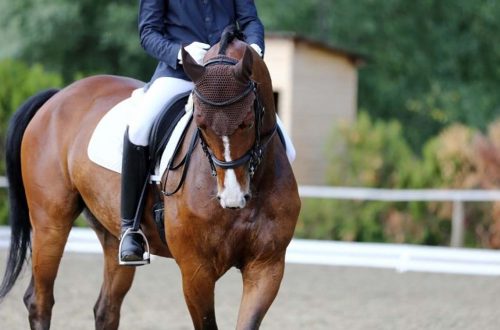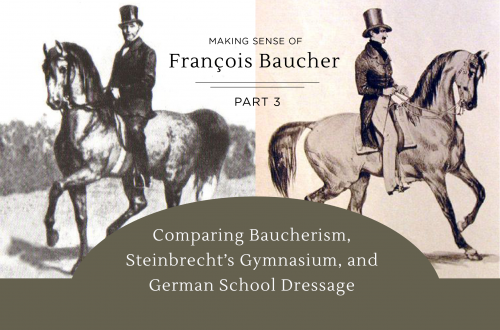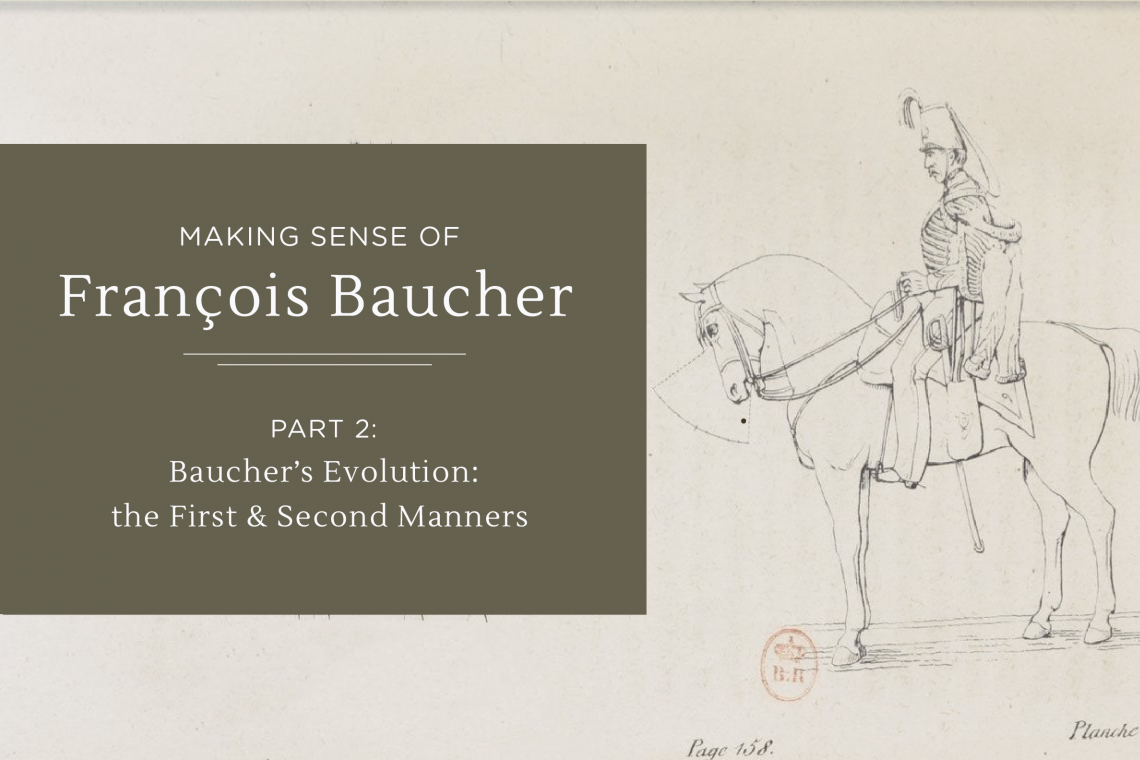
Making Sense of Baucher Part 2: Baucher’s Evolution
Over his career, François Baucher refined his methods considerably. But while his earlier work (the first manner) became quite well known, his second manner, which first appeared only in the 12th edition of his New Method of Horsemanship, sadly didn’t achieve the same reach.
Thus, there’s sometimes some vagueness about his philosophy and methods, as it can be easy to find only his first manner (especially in English), which can at times appear to contradict his later ideas. For example, the opposition of hands and legs, or the effet d’ensemble (combination of effects) in the first manner appears to contradict his later, famous principle of “hands without legs, legs without hands.”
So how can we understand how Baucher’s methods evolved? And what are the key differences between the first and second manners?
What Caused Baucher to Revise his Methods?
The change in Baucher’s methods, and the reason the second manner didn’t spread as far as the first appears to be influenced (at least in part) by the terrible accident he endured mid-career. His injuries from the accident diminished the strength in his legs, and even caused him to stop riding in public. While he was likely developing his new ideas before the accident, it seems the accident accelerated or confirmed the changes he was making to his methods.
In the second manner, we see that much less emphasis is put on the legs, by separating the hand and leg aids with the principle of “hands without legs, legs without hands.” With this, Baucher greatly reduced his use of the effet d’ensemble, and introduced the descent des jambes, or the temporary and complete release of the leg aids. It seems the accident pushed him to become ever more efficient with the aids, and by not sparing extra strength where it wasn’t needed, he thus increased his horses’ lightness to both hands and legs.
While Baucher published his new methods in the 12th edition of his New Method of Horsemanship a long 9 years after the accident, Racinet points out (in his book here) that limitations of his contract with his publisher had prevented him from making any major changes to his book any sooner.
So, by the time Baucher published his second manner, it had been almost 10 years since he had been touring Europe with the circus and demonstrating his work in the spotlight, and so his second manner did not get nearly the same exposure as the first.
What are the Key Differences Between the First and Second Manners?
While Baucher’s revisions were significant enough that it would have been of benefit to rewrite the entire method, the 12th edition of his book simply adds on the second manner as an addendum to the first manner – despite appearing in places to contradict it. The fact that his earlier and later ideas were never unified with their differences has likely and understandably added to some confusion about his methods.
To bring some clarity to this situation, we can distill the most important changes in his methods into the following 3 key differences between the first and second manners:
- “Hands without legs, legs without hands”
In the first manner, Baucher puts much more emphasis on using hands and legs at the same time, using the effet d’ensemble (from the 5th ed. onward) to bring the horse into balance. Baucher wrote that (in the 9th edition) after thoroughly suppling the horse’s neck, throat, and hindquarters;
“We must now reunite these forces in their true centre of gravity, that is, the middle of the animal’s body, [and] it is by the properly combined opposition of the legs and hands that we will succeed in this.”
“The combination of effects means the continued and exactly opposed force of the hand and legs. Its object should be to bring back again into a position of equilibrium all the parts of the horse which leave it, in order to prevent him from going ahead, without backing him, and vice versa: finally, it serves to stop any movement from the right to the left, or the left to the right. By this means, also, we distribute the weight of the mass equally on the four legs, and produce temporary immobility.”
While of fundamental importance in the first manner as a means to bring into and keep the horse in balance by distributing the horse’s weight, by the second manner Baucher realized he could use a soft flexion of the jaw to achieve lightness and balance instead.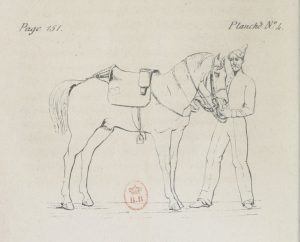
Baucher performing a flexion of the jaw That is, Baucher would ask for a soft yielding of the jaw and mouthing of the bit to confirm the horse’s lightness, and he began to see this process as fundamentally necessary to enable balance.
As the soft mobility of the jaw and mouth replaced much of his use of the effet d’ensemble, the opposition of hands and legs was then left only for teaching a horse to stop (introducing immobility), calming a horse, or momentarily regulating a gait. However, even with teaching a horse to stop, Baucher writes in the second manner (as translated by Racinet) that;“To stop his horse, the rider will at first use the ‘effet d’ensemble,’ but soon, the hand will suffice to stop a horse straight in his shoulders and haunches.”
Thus, reducing the use of the effet d’ensemble drastically reduced the need for the legs, and opened up the possibility of introducing the descent des jambes, or temporary and complete release of the leg aids.
At the same time, Baucher began to increasingly separate the hand and leg aids, making them more efficient. This led to Baucher’s setting forward his famous axiom in the second manner of “hands without legs, legs without hands.”
As Racinet explains,“Baucher was led to set forth this principle out of a concern for “economy of the means.” Indeed, if one cares about lightness, one will try to avoid “bombarding” the horse with forceful and sometimes contradictory signals. If one succeeds in keeping a horse in proper balance through a combination of aids (the aids acting simultaneously), it means that perhaps the legs have had to correct the errors or excesses of the hand, and vice versa. These errors have been unaccounted for; the result is safe, but the manner was coarse. There has been lack of opportunity. If the hand or the legs act alone, they will have to reach their optimal threshold of efficacy. The rider will become efficient and subtle; the horse will become attentive and calm. But the horse will become not only calm but also highly sensitive to the legs, since hand and legs will no longer erase each other’s conditioning…”
This allowed Baucher to refine his methods into a new kind of riding, where, if the horse was kept in balance, hand and leg aids would then be used (separately) only to begin a movement or transition or to modify a gait or position, but never to continuously maintain it. The aids could otherwise rest, allowing for both the descent de main (release of the hand, introduced by La Guérinière) and the descent des jambes (release of the legs).
Baucher explains (as in Racinet Explains Baucher) that separating the aids and so making them more efficient allows one to reduce their use to the point where the horse can move in balance on a complete release of the aids.“By using only one force at a time, whether that of the legs to give impulsion or that of the hand to operate the transference of weight needed by such and such a movement, such and such a gait, the rider can assess instantly the degree of appropriateness he has displayed. If he commits an error, he can correct it at once; he knows its cause, and the poor horse, being no longer tossed about between these two opposite wills of hand and legs, identifies himself so much with the thoughts of his master that soon these two intelligences make only one, the horse keeping his perfect equilibrium without the help of his rider’s hand or legs.”
As we can see, Baucher shifted from using the opposition of hands and legs in the effet d’ensemble to using “hands without leg, legs without hands” as a general rule in the second manner. He achieved this by prioritizing the soft mobility of the jaw to create lightness and balance, and by using the hand and leg aids separately (for the most part), which led him to be able to ride on a complete release of the aids.
- Ramener: The classical headset – from prerequisite for balance to its result
Baucher’s perspective on and use of the ramener or classical headset (forehead of the horse vertical with the poll being the highest point) also changed quite drastically.
At the time of the first manner, Baucher believed that asking for and setting the horse’s head into the classical position (with a ‘direct flexion of the head and neck,’ where he would ask the horse to bring the head into a vertical position) was a crucial prerequisite for developing lightness and balance. He writes in the 9th edition that;
“This is the most important flexion of all; the others tended principally to pave the way for it. As soon as it is executed with ease and promptness, as soon as [a] light touch is sufficient to place and keep the head in a perpendicular position, it will prove that the suppling is complete, contraction destroyed, lightness and equilibrium established in the forehand. The direction of this part of the animal will, henceforward, be as easy as it is natural, since we have put it in a condition to receive all our impressions, and instantly to yield to them without effort.”
He writes that this lightness created would then be confirmed by the horse gently mouthing the bit;“The horse will have completely yielded to the action of the hand, when his head is carried in a position perfectly perpendicular to the ground; from that time the contraction will cease, which the animal will show, as in every other case, by champing his bit.”
Now, while he saw perfecting the ramener as the prerequisite for lightness and balance in the first manner, by the second manner Baucher saw it completely differently.
Instead, he saw the classical headset as the result of lightness and collection.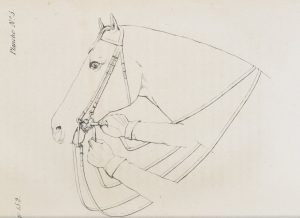
Baucher performing a flexion of the jaw. Baucher increasingly found that the ramener would come about on its own through developing collection and maintaining lightness with a soft and mobile mouth. Thus, he stopped seeking for the classical headset directly through the ‘direct flexion of the head and neck,’ and instead focused on perfecting the soft mouthing of the bit (to confirm the softness of the jaw and to release contractions), as well as on developing collection.
In addition, Baucher also began to see benefit in performing flexions with the horse’s head high and almost horizontal. He would then ask for the softness of the mouth in this position and, as Faverot de Kerbrech, a student of Baucher’s explains (in Racinet’s book);“One relaxes the jaw, the head being high and almost horizontal. Then only should one allow it to near the perpendicular line. But with a horse prepared in this way, the ‘ramener’ comes about fast and soon becomes easy to maintain.”
This leads us to the last major difference between Baucher’s first and second manners: - Raising the head and neck
In the second manner, Baucher introduces work with the head raised in the first stage of the horse’s training. This, he found, functions to shift the horse’s weight from front to back by lifting the withers, and so helps to improve the horse’s balance. As Faverot de Kerbrech explains;
“During all this first period of the training, one must seek to raise the neck as much as possible. It is upon the weight that one acts by demanding this elevation”
Baucher recognized that, biomechanically, the lower the horse’s head, the more weight is placed on the forehand. Thus, as he sought to create lightness and balance by shifting the weight back (as dressage training aims to do), he found that lifting the head and neck enabled him to essentially lift the withers, and cause the horse to bring its hind end further underneath itself and to ‘sit’ more on its haunches. He explains in Main sans Jambes (as quoted in Racinet Explains Baucher);“Now one should not let the horse ‘bury himself’ and lower the neck in order to set the head vertically, because the lower the neck, the farther away the head is from the body, the less it is possible to achieve balance and to ‘sit’ the horse in order to make him execute brilliant movements”
And so, Baucher also began teaching this work with the horse’s head raised early in a horse’s training.
In Summary
While Baucher’s first manner is much more well known – and was well criticized in his time – there are significant differences between the first and second manners. This makes it all the more important to discover how Baucher reformed his methods as time went on, even if (and perhaps more so because) the second manner didn’t become as well known as the first.
Baucher changed his methods from using the opposition of hands and legs (effet d’ensemble) and placing the head in a vertical position (ramener) for achieving balance, to using “hands without legs, legs without hands” and relying ever more so on attaining a soft mobility of the mouth to confirm lightness, through which balance could then be obtained with collected work.
In the second manner, Baucher also introduced the descent des jambes and exercises with the head and neck raised. The first resulted from separating the hand and leg aids which allowed the aids to rest when not needed, and the second from Baucher’s realization that he could thereby lift the withers, shift the horse’s weight back, and so improve balance at the beginning of training.
Thus, Baucher dramatically shifted his ideas between the first and second manners.
In reading critiques of Baucher’s work, it’s also important to understand which era of Baucher’s work is being discussed – the first or the second manner?
This way, we can understand exactly where his critics differed, and appreciate his work and evolution as a whole to better identify what parts of his work we can learn from, and adapt to serve us in our own riding and training of horses.



